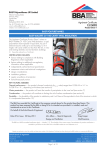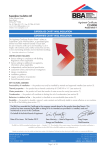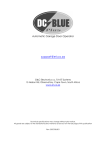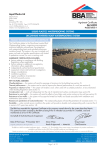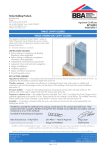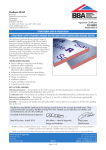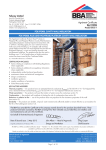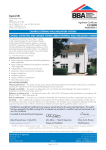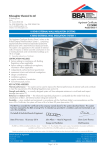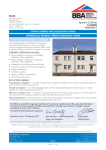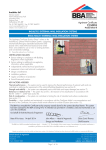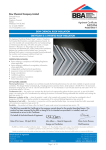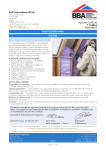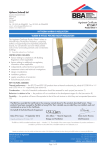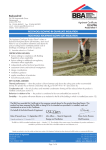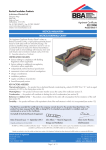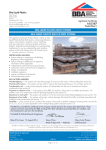Download Lapolla Industries, Inc. LAPOLLA CAVITY FILL INSULATION
Transcript
Lapolla Industries, Inc. APPROVAL INSPECTION TESTING CERTIFICATION 15402 Vantage Parkway East Suite 322 Houston Texas USA 77032 Tel: 001 281 219 4100 Fax: 001 281 219 4106 TECHNICAL APPROVALS FOR CONSTRUCTION Agrément Certificate 14/5095 e-mail: [email protected] website: www.lapolla.com Product Sheet 1 LAPOLLA CAVITY FILL INSULATION LAPOLLA FOAM-LOK CAVITY FILL INSULATION This Agrément Certificate Product Sheet (1) relates to Lapolla FOAM-LOK Cavity Fill Insulation, a rigid polyurethane foam injected in liquid form, for use in external masonry walls up to and including 12 metres in height, with cavity widths not less than 40 mm and not greater than 150 mm, in existing domestic and nondomestic buildings. (1) Hereinafter referred to as ‘Certificate’. CERTIFICATION INCLUDES: • factors relating to compliance with Building Regulations where applicable • factors relating to additional non-regulatory information where applicable • independently verified technical specification • assessment criteria and technical investigations • design considerations • installation guidance • regular surveillance of production • formal three-yearly review. KEY FACTORS ASSESSED Thermal performance — the product has an estimated thermal conductivity (estimated) of 0.033 W·m–1·K–1 (see section 6). Water resistance — the product will resist the transfer of precipitation to the inner leaf (see section 7). Condensation — the product will contribute to limiting the risk of surface condensation (see section 8). Durability — the product will have a life equivalent to that of the structure in which it is incorporated (see section 12). The BBA has awarded this Certificate to the company named above for the product described herein. This product has been assessed by the BBA as being fit for its intended use provided it is installed, used and maintained as set out in this Certificate. On behalf of the British Board of Agrément Date of First issue: 17 February 2014 John Albon — Head of Approvals Claire Curtis-Thomas Energy and Ventilation Chief Executive The BBA is a UKAS accredited certification body — Number 113. The schedule of the current scope of accreditation for product certification is available in pdf format via the UKAS link on the BBA website at www.bbacerts.co.uk Readers are advised to check the validity and latest issue number of this Agrément Certificate by either referring to the BBA website or contacting the BBA direct. British Board of Agrément Bucknalls Lane Watford Herts WD25 9BA ©2014 Page 1 of 10 tel: 01923 665300 fax: 01923 665301 e-mail: [email protected] website: www.bbacerts.co.uk Regulations In the opinion of the BBA, Lapolla FOAM-LOK Cavity Fill Insulation, if installed, used and maintained in accordance with this Certificate, can satisfy or contribute to satisfying the relevant requirements of the following Building Regulations (the presence of a UK map indicates that the subject is related to the Building Regulations in the region or regions of the UK depicted): The Building Regulations 2010 (England and Wales) (as amended) Requirement: C2(a) Resistance to moisture Comment: Requirement: C2(b) Resistance to moisture Comment: Requirement: C2(c) Resistance to moisture Comment: Requirement: L1(a)(i) Conservation of fuel and power Comment: Regulation: Materials and workmanship The product can contribute to satisfying this Requirement. See section 7.1 of this Certificate. The product can contribute to satisfying this Requirement. See sections 7.1 and 7.2 of this Certificate. The product can contribute to satisfying this Requirement. See sections 8.1 and 8.3 of this Certificate. The product can contribute to satisfying this Requirement. See sections 6.1 and 6.3 of this Certificate. 7 The product is an acceptable material. See section 12 and the Installation part of this Certificate. Comment: The Building (Scotland) Regulations 2004 (as amended) Regulation: 8(1) Regulation: Standard: 9 2.6 3.4 3.10 3.15 6.1(b) 6.2 Carbon dioxide emissions Building insulation envelope This product can contribute to satisfying clauses, or parts of, 6.1.1(1), 6.1.2(2), 6.1.6(1), 6.1.10(2), 6.2.1(1)(2), 6.2.3(1), 6.2.4(2), 6.2.5(2), 6.2.6(1), 6.2.7(1), 6.2.8(1)(2), 6.2.9(1)(2), 6.2.10(1)(2), 6.2.11(1)(2), 6.2.12(2) and 6.2.13(1)(2) of these Standards. See sections 6.1 and 6.3 of this Certificate. Comment: Regulation: Condensation The product can contribute to satisfying this Standard, with reference to clauses 3.15.1(1)(2), 3.15.4(1)(2) and 3.15.5(1)(2). See sections 8.2 and 8.3 of this Certificate. Comment: Standard: Standard: Precipitation The product can contribute to satisfying this Standard, with reference to clause 3.10.1(1)(2), provided it complies with the conditions set out in sections 7.1 and 7.2 of this Certificate. Comment: Standard: Moisture from the ground The product contributes to satisfying this Standard, with reference to clause 3.4.1(1)(2). See section 7.1 of this Certificate. Comment: Standard: Building standards applicable to construction Spread to neighbouring buildings The product is not non-combustible but may be used in walls of domestic and non-domestic buildings in accordance with the exceptions permitted in the Standard, with reference to clauses 2.6.5(1) and 2.6.6(2). See section 9.5 of this Certificate. Comment: Standard: Durability, workmanship and fitness of materials The product can contribute to satisfying this Regulation. See section 12 and the Installation part of this Certificate. Comment: 12 Building standards applicable to conversions Comments made in relation to the product under Regulation 9 Standards 1 to 6 also apply to this Regulation, with reference to clause 0.12.1(1)(2) and Schedule 6(1)(2). Comment: (1) Technical Handbook (Domestic). (2) Technical Handbook (Non-Domestic). The Building Regulations (Northern Ireland) 2012 Regulation: 23 Fitness of materials and workmanship Comment: Regulation: 28(a) Resistance to moisture and weather Comment: Regulation: 28(b) Resistance to moisture and weather Comment: Regulation: 29 Condensation Comment: Regulation: Regulation: 39(a)(i) 40(2) Conservation measures Target carbon dioxide emission rate Comment: The product is an acceptable material. See section 12 and the Installation part of this Certificate. The product can contribute to satisfying this Regulation. See section 7.1 of this Certificate. The product can contribute to satisfying this Regulation. See sections 7.1 and 7.2 of this Certificate. The product can contribute to satisfying this Regulation. See section 8.3 of this Certificate. The product can contribute to satisfying these Regulations. See sections 6.1 and 6.3 of this Certificate. Page 2 of 10 Construction (Design and Management) Regulations 2007 Construction (Design and Management) Regulations (Northern Ireland) 2007 Information in this Certificate may assist the client, CDM co-ordinator, designer and contractors to address their obligations under these Regulations. See section: 3 Delivery and site handling (3.1 to 3.3) of this Certificate. Additional Information NHBC Standards 2014 In the opinion of the BBA, the use of Lapolla FOAM-LOK Cavity Fill Insulation, in relation to this Certificate, is not subject to the requirements of these Standards. Technical Specification 1 Description 1.1 Lapolla FOAM-LOK Cavity Fill Insulation is a yellow, urethane foam compound. 1.2 It is injected into the wall as a syrup from a hand gun, through nominal 12 mm diameter holes spaced in a predetermined pattern. 1.3 The material is foamed in-situ by the mixing of isocyanate and resin components. The resultant mix is soft and fluid but quickly expands within the cavity and hardens to a rigid foam mass. 1.4 The product has an installed density in the range of 30 kg·m–3 to 40 kg·m–3. 2 Manufacture 2.1 A batch of materials are blended together to produce the liquid resin component which, when mixed with the isocyanate component, meets the requirements of BS EN 14318-1 : 2013. 2.2 As part of the assessment and ongoing surveillance of product quality, the BBA has: • agreed with the manufacturer the quality control procedures and product testing to be undertaken • assessed and agreed the quality control operated over batches of incoming materials • monitored the production process and verified that it is in accordance with the documented process • evaluated the process for management of nonconformities • checked that equipment has been properly tested and calibrated • undertaken to carry out the above measures on a regular basis through a surveillance process, to verify that the specifications and quality control operated by the manufacturer are being maintained. 3 Delivery and site handling 3.1 The two components are delivered to site in drums (typically 227 kg capacity) bearing the product name and batch number. 3.2 Drums should be stored between 10°C and 32°C, away from possible ignition sources and protected from frost. 3.3 The isocyanate is classified as ‘harmful’ and the polyol (a component contained in the resin) as an ‘irritant’ under The Chemicals (Hazard Information and Packaging for Supply) Regulations 2009 (CHIP4)/Classification, Labelling and Packaging of Substances and Mixtures (CLP Regulation) 2009. The packaging must bear the appropriate hazard warning labels. When cured, Lapolla FOAM-LOK Cavity Fill Insulation does not constitute a hazard. Assessment and Technical Investigations The following is a summary of the assessment and technical investigations carried out on Lapolla FOAM-LOK Cavity Fill Insulation. Design Considerations 4 General 4.1 Lapolla FOAM-LOK Cavity Fill Insulation is satisfactory for use as an injected cavity wall insulation and is effective in reducing the thermal transmittance (U value) of external cavity walls, with masonry inner and outer leaves (where masonry includes clay and calcium silicate bricks, concrete blocks, and natural and reconstituted stone blocks). The product is for use in existing domestic and non-domestic buildings up to and including 12 metres in height, with cavity widths not less than 40 mm and no greater than 150 mm. It is essential that such walls are designed and constructed to incorporate the precautions given in this Certificate to prevent moisture penetration. 4.2 The suitability of walls for insulation must be assessed in accordance with BS EN 14318-2 : 2013. Page 3 of 10 4.3 This Certificate covers the use of the product in any exposure zone(1), subject to the following conditions being met. They are particularly important in areas which may experience severe or very severe driving rain. • a site survey should be carried out prior to installation (see sections 13 and 14). • the minimum cavity width must be not less than 40 mm • walls must be in a good state of repair and show no evidence of frost damage • mortar joints must not show evidence of more than hairline cracking. Raked or recessed mortar joints should be avoided in very severe exposure areas. (1) Exposure zones defined in BRE Report BR 262 : 2002. 4.4 The product may be installed only where: • there are no signs of dampness on the inner face of the cavity wall, other than those caused solely by condensation, and • the cavity is not being used as a source of combustion air or as a flue for ventilation purposes. Partial filling — omitted areas 4.5 Whenever practicable, all of the cavity space from ground level to the roof or gable copings should be filled, except: • when separately insulating semi-detached or terraced properties • up to the underside of a horizontal boundary, other than the roof, where that horizontal boundary is protected by a cavity tray or similar waterproof barrier • when treating properties where the wall to be insulated is below a waterproof cladding (eg tile hung) and this cladding either extends up to the roof or is protected at the top by other means (eg window sills) • when treating areas of wall where access for drilling may be limited by features such as carports and conservatories, as defined in sections 17.13 and 17.14. 5 Practicability of installation The product must be installed by operatives trained and approved by the Certificate holder and subsequently approved by the BBA. The Certificate holder operates an Approved Installer Scheme(1) for this system under which the installers are approved, registered and regularly reviewed by the Certificate holder to demonstrate that they are competent to carry out installations of the system in accordance with this Certificate. Details of Approved Installers are available from the Certificate holder. Approved Installers are responsible for each installation of the product that they undertake (see section 15). (1) The Certificate holder’s records relating to their Approved Installer Scheme will be audited annually by the BBA as part of its programme of surveillance. 6 Thermal performance 6.1 Calculations of the thermal transmittance (U value) of specific external wall constructions should be carried out in accordance with BS EN ISO 6946 : 2007 and BRE Report BR 443 : 2006, using the insulation’s estimated thermal conductivity (estimated) of 0.033 W·m–1·K–1. Note: An estimated figure has been provided in the absence of an actual declared figure, based upon the mean figure plus a correction factor of 0.005 W·m–1·K–1. 6.2 Where an existing wall is subject to national Building Regulations, for example subject to a material change of use, designers should take account of the relevant guidance relating to technical and economic feasibility and target U values in the documents supporting those Regulations. 6.3 The U value of a typical brick and block cavity wall construction will depend on the cavity width and the insulating value of the internal block leaf finish. Calculated U values for sample constructions are given in Table 2 for existing buildings. Table 2 Example cavity wall U values — existing/retained walls Cavity width/ insulation thickness (mm) U values (W·m–2·K–1) (1) 13 mm dense plaster(2) Plasterboard on dabs 100 mm dense block 100 mm AAC block(4) (3) 40 50 75 100 125 150 0.62 0.52 0.38 0.30 0.25 0.21 0.42 0.37 0.29 0.24 0.21 0.18 (1) Assumes 102 mm thick brick outer leaf, mild steel double-triangle wall ties (12.5 mm2) at 2.5 m2 and 6.7% mortar (0.88 W·m–1·K–1) bridging inner block leaf (2) Dense plaster 0.57 W·m–1·K–1 (3) Dense block at 1.13 W·m–1·K–1 (4) AAC block at 0.12 W·m–1·K–1 Page 4 of 10 6.4 The product can maintain, or contribute to maintaining, continuity of thermal insulation at junctions between elements. For Accredited Construction Details, the corresponding -values (psi) in BRE Information Paper IP 1/06, Table 3, may be used in carbon emission calculations in Scotland and Northern Ireland. Detailed guidance for other junctions and on limiting heat loss by air infiltration can be found in: England and Wales — Approved Documents to Part L and, for new thermal elements to existing buildings, Accredited Construction Details (version 1.0). Also see SAP 2009 The Government’s Standard Assessment Procedure for Energy Rating of Dwellings, Appendix K and the iSBEM User Manual for new-build Scotland — Accredited Construction Details (Scotland) Northern Ireland — Accredited Construction Details (version 1.0). 7 Water resistance 7.1 The product can be used in situations where it bridges the damp-proof course (dpc) in walls; dampness from the ground will not pass through to the inner leaf provided the wall is detailed in accordance with the requirements and provisions of the national Building Regulations: England and Wales — Approved Document C, section 5 Scotland — Mandatory Standard 3.4, clause 3.4.1(1)(2) (1) Technical Handbook (Domestic). (2) Technical Handbook (Non-Domestic). Northern Ireland — Technical Booklet C, Sections 6.3 to 6.6. 7.2 When the product is properly installed in accordance with this Certificate, it will resist any water transfer across the cavity to the inner leaf. 8 Condensation Surface condensation 8.1 Walls will limit the risk of surface condensation adequately when the thermal transmittance (U value) does not exceed 0.7 W·m–2·K–1 at any point and the junctions with floors, roofs and openings are designed in accordance with Limiting thermal bridging and air leakage : Robust construction details for dwellings and similar buildings (TSO 2002), BRE Information Paper IP 1/06 or section 6.4 of this Certificate. 8.2 For buildings in Scotland, constructions will be acceptable where the thermal transmittance (U value) of the wall does not exceed 1.2 W·m–2·K–1 at any point and openings and junctions with other elements comply with the guidance given in BS 5250 : 2011, Annex G, and section 6.4 of this Certificate. Additional information can be found in BRE Report BR 262 : 2002. Interstitial condensation 8.3 Walls will limit the risk of interstitial condensation adequately when they are designed and constructed in accordance with BS 5250 : 2011, Annexes D and G. 8.4 For the purposes of assessing the risk of interstitial condensation, the water vapour resistivity of the product may be taken as approximately 380 MN·s·g–1·m–1. 9 Behaviour in relation to fire 9.1 The use of the product does not prejudice the fire resistance properties of the wall. It is unlikely to become ignited within the cavity when used in the context of this Certificate. If fire does penetrate into the cavity, the amount of air present will be insufficient to support combustion. However, the instructions contained in this Certificate relating to the sealing of an uncapped cavity and the removal of any insulant present in the loft space after installation (section 17.12) must be carefully followed. 9.2 The requirements of the Building Regulations relating to fire spread in cavity walls can be met in buildings of all purpose groups without the need for cavity barriers, provided the construction complies with the provisions detailed in: England and Wales — Approved Document B, Volume 1, Diagram 13 and Volume 2, Diagram 34 Northern Ireland — Technical Booklet E, Diagram 4.5. 9.3 For buildings subject to the Building Standards in Scotland, cavity barriers are not required to limit the area of a cavity or at junctions with other wall cavities. However, cavity barriers are required around openings, penetrations and junctions with roof or floor cavities, with reference to clauses 2.4.1(1)(2), 2.4.2(1)(2), 2.6.5(1) and 2.6.6(2). (1) Technical Handbook (Domestic). (2) Technical Handbook (Non-Domestic). 9.4 For constructions not covered by sections 9.2 and 9.3, cavity barriers must be provided to comply with: England and Wales — Approved Document B, Volume 1, Section 6 and Volume 2, Section 9 Scotland — Mandatory Standard 2.4, clauses 2.4.1(1)(2) and 2.4.2(1)(2) (1) Technical Handbook (Domestic). (2) Technical Handbook (Non-Domestic). Northern Ireland — Technical Booklet E, Paragraphs 4.36 to 4.39. Page 5 of 10 9.5 The product is not classified as ‘non-combustible’ but may be used in a wall on, or less than 1 m from, a relevant boundary when installed in a cavity that is between two leaves of masonry or concrete at least 75 mm thick, and which has a cavity barrier around all openings in the wall and at the top of the wall-head. 10 Proximity of flues and appliances When installing the product in close proximity to certain flue pipes and/or heat producing appliances, the relevant provisions of the national Building Regulations are applicable: England and Wales — Approved Document J Scotland — Mandatory Standard 3.19, clauses 3.19.1(1)(2) to 3.19.9(1)(2) (1) Technical Handbook (Domestic). (2) Technical Handbook (Non-Domestic). Northern Ireland — Technical Booklet L. 11 Maintenance As the product is confined within the wall cavity and has suitable durability (see section 12), maintenance is not required. 12 Durability The product is unaffected by the normal conditions in a wall and is durable, rot proof, water resistant and sufficiently stable to remain effective as insulation for the life of the building. Installation 13 Site assessment Prior to the installation, an assessment must be carried out by a trained assessor, who may also be the installing technician, to ascertain the suitability of the property or properties to receive Lapolla FOAM-LOK Cavity Fill Insulation. An assessment report is prepared and held at the installer’s offices. Particular problems are specifically identified and any reasons for rejection of the work noted. Care should be taken at this stage for the assessor and the party commissioning the work to identify, and agree in writing as appropriate, any areas of the wall that will not be filled (see section 17.14) and any special requirements for making good (see section 17.11). 14 Site preparation 14.1 The installing operative ensures that the property has been correctly assessed and is suitable for insulation with the product. Any problems encountered during installation which prevent compliance with this Certificate are referred to the installation company before proceeding. 14.2 Essential ventilation openings (such as those providing combustion air or underfloor ventilation) and all flues in the cavity wall must be checked. If adequate sleeving or other cavity closures are not present, installation must not proceed until these openings have been sleeved or otherwise modified to prevent blockage by the insulant. 14.3 All gaps and cracks in the inner and outer leaves and the tops of uncapped cavities are sealed where possible to limit any escape of the material during installation. 15 Approved installers Installation of the product is carried out by the Certificate holder or their approved installers. An approved installer is defined as a company: • required to satisfy an initial site installation check by the BBA following approval by the Certificate holder and is subject to the BBA Assessment and Surveillance Scheme for Installation of Cavity Wall Insulation • approved by the Certificate holder and the BBA to install the product • having undertaken to comply with the Certificate holder’s installation procedure • employing technicians who have been issued with appropriate identity cards by the Certificate holder; at least one member of each installation team must carry a card • subject to inspections by the Certificate holder. The Certificate holder oversees the activities of approved installers operating under the BBA Surveillance Scheme for Cavity Wall Insulation. It is a requirement that the Certificate holder undertakes inspections to each card-carrying technician using their product and maintains records, as detailed in the BBA Assessment and Surveillance Scheme for BBA Approved Installers of Cavity Wall Insulation. 16 Supervision 16.1 Installation of the product should be carried out in accordance with the BBA Assessment and Surveillance Scheme for Installation of Cavity Wall Insulation. Page 6 of 10 16.2 During installation, the following simple checks can be made as an aid to determining that the installation conforms to the certificated method: • the pattern of holes complies with the description given in section 17.4, 17.5 and 17.6 • injection of material takes place in each shot hole, to complete the filling of the cavity space. 17 Procedure Injection equipment 17.1 The installer provides all required materials and equipment for the installation, plus material for cosmetic repair of the wall at the completion of the injection process. The injection equipment is comprised of an air-driven, hydraulic or electrically-driven proportioning device capable of delivering the material at the required pressure and temperature. 17.2 The isocyanate and resin is mixed at a ratio of 1:1 by volume. This product is injected into the wall using a spray gun with a 42/42 mix chamber and metal directional injection adapter to ensure material is correctly installed into the cavity. Injection holes 17.3 The injection holes should be 12 mm in diameter and drilled into the exterior leaf into the mortar joints. 17.4 The first injection hole should be 225 mm above the dpc (ie the height of 3 bricks) and at a maximum of 450 mm from the edge of the wall (ie 2 brick lengths). This row of injection holes continues across the wall, with the holes located a maximum of 450 mm apart. The second row should be started 225 mm above the first row, with the first hole located 225 mm from the edge of the wall (ie one brick length). The remaining holes in this row should be spaced a maximum of 450 mm apart. The rows are continued in this manner until the top of the wall is reached. A staggered pattern of holes should be achieved, to ensure complete fill of the cavity wall — see Figure 1 for example of staggered drilling pattern. 17.5 The pattern should be adjusted for wide cavities and in areas near to building features of the wall (such as party walls and openings), where holes should be 225 mm from the feature edge and continued vertically with 225 mm spacing. When dealing with a dividing line of an attached property which is not being insulated, it is essential to leave a vertical boundary of polyurethane foam adjacent to the neighbouring cavity, so that water running down the untreated cavity will not collect at any point on the edge of the filled area. Typical drilling patterns are shown in Figure 1 and 2. Figure 1 Typical drilling patterns 225 mm (1 brick) 225 mm (1 brick) 75 mm 225 mm (3 bricks) 450 mm (2 bricks) staggered drilling pattern drilling pattern at roof level 450 mm (2 bricks) door or window opening door and window frame drill pattern 225 mm (3 bricks) 225 mm (1 brick) 225 mm (3 bricks) 225 mm drilling pattern at a party wall Page 7 of 10 Figure 2 Typical drilling pattern Sight Holes 17.6 Sight holes should be placed at each end of the wall and located 125 mm from the edge and 225 mm from the bottom to ensure that the ends of the wall are completely filled. These sight holes are not part of the standard injection pattern but are used to ensure the complete fill of the cavity. The pattern is continued vertically to the top of the wall, with each sight hole 450 mm apart in height. Calibration shots 17.7 It is essential that a calibration/quality control shot be taken before installation and at the end of each hour of application to ensure correct shot size and foam quality including cream time, gel time and density. Injection procedure 17.8 In each of the main sections, injection of foam should proceed horizontally, ensuring that no injection hole is missed and that the cavity is fully filled from the bottom upwards. The injection time for each hole should be based on cavity width and calibration shots, as described in section 17.7. However, as inspection of the shots occurs, the time may be adjusted based on the actual filling of the wall to ensure a complete fill is attained. 17.9 Polyurethane foam systems should not be injected into a hole for more than its cream time. It is essential to use indicator sticks during the injection. These should be placed in the holes at the injection point to establish the presence of the polyurethane foam system and, after gelation, removed. 17.10 The installation manual should be referred to for each aspect of the procedure. Finishing 17.11 After injection, the drill holes are fully filled with mortar of a similar type, colour, texture and weathertightness to that of the existing wall. Where a wall requires a high degree of colour matching, the level of finish-matching should be agreed in writing during the site assessment. All trunked air vents eg those providing underfloor ventilation and combustion air for heating appliances, are checked — any obstructions must be cleared. All flues must be carefully checked by an appropriate test (eg a smoke test) to verify that they are clear and unobstructed. 17.12 If the cavity is uncapped, any insulant which has expanded over the top of the cavity into the loft space is removed. The top of the insulant is then, where possible, isolated from the roof structure by suitably shaped plugs of mineral wool. Page 8 of 10 Omitted areas 17.13 In some circumstances, access for drilling injection holes and filling with insulation may be limited by features such as carports, conservatories, cladding or tiling. The practicability of safely accessing and making good these areas, or installing the insulation through the inner leaf, may outweigh the benefits of insulating these areas. 17.14 It is permissible to omit such areas only when: • a full justification detailing the reasons to omit areas is included in the survey report • the assessor obtains written consent for omitting any areas of the wall from the party commissioning the work. The assessor must communicate that heat loss through uninsulated areas will not be reduced, and that uninsulated areas will also be subject to a slightly higher risk of condensation. Technical Investigations 18 Tests Tests were carried out on Lapolla FOAM-LOK Cavity Fill Insulation and the results assessed to determine: • thermal conductivity • adhesion between foam and masonry • foam density • water vapour permeability of the foam • shear strength • dimensional stability • compressive strength • resistance to penetration of liquid water • adequacy of fill of a cavity space. 19 Investigations 19.1 The manufacturing process was examined, including the methods adopted for quality control, and details were obtained of the quality and composition of the materials used. 19.2 The company’s training arrangements were examined and approved. 19.3 A condensation risk analysis was carried out. 19.4 A series of U value calculations was carried out. 19.5 A calculation was undertaken to confirm the thermal conductivity (estimated). Bibliography BS 5250 : 2011 Code of practice for control of condensation in buildings BS EN 14318-1 : 2013 Thermal insulating products for buildings — In-situ formed dispensed rigid polyurethane (PUR) and polisocyanurate (PIR) foam products — Specification for the rigid foam dispensed system before installation BS EN 14318-2 : 2013 Thermal insulating products for buildings — In-situ formed dispensed rigid polyurethane (PUR) and polisocyanurate (PIR) foam products — Specification for the installed insulation products BS EN ISO 6946 : 2007 Building components and building elements — Thermal resistance and thermal transmittance — Calculation method BRE Information Paper IP 1/06 Assessing the effects of thermal bridging at junctions and around openings BRE Report (BR 262 : 2002) Thermal insulation: avoiding risks BRE Report (BR 443 : 2006) Conventions for U-value calculations Page 9 of 10 Conditions of Certification 20 Conditions 20.1 This Certificate: • relates only to the product/system that is named and described on the front page • is issued only to the company, firm, organisation or person named on the front page — no other company, firm, organisation or person may hold or claim that this Certificate has been issued to them • is valid only within the UK • has to be read, considered and used as a whole document — it may be misleading and will be incomplete to be selective • is copyright of the BBA • is subject to English Law. 20.2 Publications, documents, specifications, legislation, regulations, standards and the like referenced in this Certificate are those that were current and/or deemed relevant by the BBA at the date of issue or reissue of this Certificate. 20.3 This Certificate will remain valid for an unlimited period provided that the product/system and its manufacture and/or fabrication, including all related and relevant parts and processes thereof: • are maintained at or above the levels which have been assessed and found to be satisfactory by the BBA • continue to be checked as and when deemed appropriate by the BBA under arrangements that it will determine • are reviewed by the BBA as and when it considers appropriate. 20.4 The BBA has used due skill, care and diligence in preparing this Certificate, but no warranty is provided. 20.5 In issuing this Certificate, the BBA is not responsible and is excluded from any liability to any company, firm, organisation or person, for any matters arising directly or indirectly from: • the presence or absence of any patent, intellectual property or similar rights subsisting in the product/system or any other product/system • the right of the Certificate holder to manufacture, supply, install, maintain or market the product/system • actual installations of the product/system, including their nature, design, methods, performance, workmanship and maintenance • any works and constructions in which the product/system is installed, including their nature, design, methods, performance, workmanship and maintenance • any loss or damage, including personal injury, howsoever caused by the product/system, including its manufacture, supply, installation, use, maintenance and removal • any claims by the manufacturer relating to CE marking. 20.6 Any information relating to the manufacture, supply, installation, use, maintenance and removal of this product/ system which is contained or referred to in this Certificate is the minimum required to be met when the product/system is manufactured, supplied, installed, used, maintained and removed. It does not purport in any way to restate the requirements of the Health and Safety at Work etc. Act 1974, or of any other statutory, common law or other duty which may exist at the date of issue or reissue of this Certificate; nor is conformity with such information to be taken as satisfying the requirements of the 1974 Act or of any statutory, common law or other duty of care. British Board of Agrément Bucknalls Lane Watford Herts WD25 9BA ©2014 Page 10 of 10 tel: 01923 665300 fax: 01923 665301 e-mail: [email protected] website: www.bbacerts.co.uk










